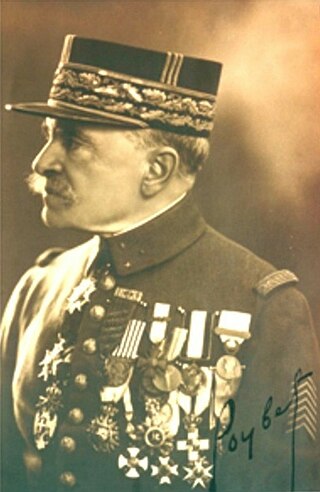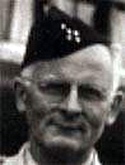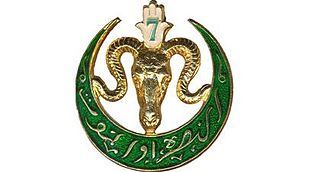The British Expeditionary Force (BEF) was the six divisions the British Army sent to the Western Front during the First World War. Planning for a British Expeditionary Force began with the 1906–1912 Haldane Reforms of the British Army carried out by the Secretary of State for War Richard Haldane following the Second Boer War (1899–1902).

Jean Jules Henri Mordacq was a French general. During his early years as a captain he was the sabre champion of the French Army's officer corps. In World War I, he was a frontline commander of initially the 159th Regiment of Alpine Infantry, then the 90th Brigade, and finally the 24th Infantry Division, in the process being wounded twice on the battlefield. In 1918 and the Paris Peace Conference, he was a close aide to Clemenceau.

Marie Émile Fayolle was a French general during World War I and a diplomat, elevated to the dignity of Marshal of France.
The 2nd Army Corps was first formed before World War I. During World War II it fought in the Campaign for France in 1940 and during the 1944–45 campaigns in southern France, the Vosges Mountains, Alsace, and southwestern Germany. It was active under the First Army for many years after World War II.

Mariano Francisco Julio Goybet was a French Army general, who held several commands in World War I.

André Zeller was a French Army general. He served during World War I, the Franco-Turkish War, and World War II, and served as chief of staff of the French Army during the Algerian War.

During World War I, France was one of the Triple Entente powers allied against the Central Powers. Although fighting occurred worldwide, the bulk of the French Army's operations occurred in Belgium, Luxembourg, France and Alsace-Lorraine along what came to be known as the Western Front, which consisted mainly of trench warfare. Specific operational, tactical, and strategic decisions by the high command on both sides of the conflict led to shifts in organizational capacity, as the French Army tried to respond to day-to-day fighting and long-term strategic and operational agendas. In particular, many problems caused the French high command to re-evaluate standard procedures, revise its command structures, re-equip the army, and to develop different tactical approaches

Louis Ernest de Maud'huy (1857–1921) was a French World War I general and the first Chief Scout of Scouts de France.
Raymond Francis Duval was a French general who participated in both World War I and World War II and was supreme commander of French troops in Tunisia and Morocco. During his career, he brutally suppressed the insurrection at Setif, Algeria in May 1945, resulting in the massacre of 6,000 to 45,000 Algerians.
Louis Charles Émile Gibon-Guilhem (1862–1945) was a French Infantry Brigadier General born in Rueil-Malmaison, France. Serving on the German front during World War I he was instrumental in the victory of allied forces in 1918.

The Battle of Hartmannswillerkopf was a series of engagements during the First World War fought for the control of the Hartmannswillerkopf peak in Alsace in 1914 and 1915. The peak is a pyramidal rocky spur in the Vosges mountains, about 5 km (3.1 mi) north of Thann, standing at 956 m (3,136 ft) and overlooking the Alsace Plain, Rhine valley and the Black Forest in Germany. Hartmanswillerkopf was captured by the French army during the Battle of Mulhouse (7–10, 14–26 August 1914). From the vantage point, Mulhouse and the Mulhouse–Colmar railway could be seen and the French railway from Thann to Cernay and Belfort shielded from German observation.

Henri Gabriel Putz was a French Army general during World War I.
The Moroccan Division or the 1st Moroccan Division of 1914, initially the Marching Division of Morocco was an infantry division of France's Army of Africa which participated in World War I.

The 8th Zouaves Regiment was an infantry unit of the French Army. Created in 1914, the unit was designated as 8th Marching Zouaves Regiment.

The 4th Tunisian Tirailleurs Regiment was an infantry regiment of the Army of Africa, part of the French Army.

The 7th Algerian Tirailleurs Regiment was an infantry unit of the French Army, part of the Army of Africa.

The 3rd Algerian Tirailleurs Regiment was an infantry unit of the Army of Africa in the French Army. Recruited primarily from Algerian Muslims, it was mainly commanded by French officers. The racial boundaries were not absolute, with some French volunteers serving in the ranks and a limited number of Muslims being appointed as officers. After 1913 a selective form of conscription was applied to Algerian Muslims but the majority of Muslim soldiers serving in the 3e R.T.A continued to be voluntarily enlisted.

Marie Jean Auguste Paulinier was a French general who held many different commands and most notable for commanding the VI Corps during World War I.

Adrien Paul Alexandre Chrétien was a French general who participated in World War I. He spent the war commanding the 30th Army Corps at throughout several battles of the Western Front.

Pierre Émile Berdoulat (1861-1930) was a French Divisional General who participated in World War I. He participated in the battles of the 2nd Champagne and the Somme before becoming the Military governor of Paris from 1919 to 1923.















